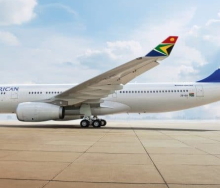Comair has received two signed non-binding offers from potential investors prepared to recapitalise the airline and negotiations continue with all stakeholders to secure the future of the airline, ceo Wrenelle Stander confirmed in a notice to staff on Friday.
This follows a Business Maverick article alleging that Comair’s business rescue was at risk because it was unable to raise short-term and long-term capital to save the airline. In the staff notice, Wrenelle said it was unfortunate that ongoing negotiations had spilled into the public domain. The airline would provide more information and clarity as it became available, she said. Wrenelle has declined to comment further in the media.
Comair’s business rescue plan is due to be published on Tuesday, July 28. This should shed more light on the investor proposals being assessed, both reportedly offering up to R1,5bn in the form of debt and equity, including a cash injection.
Meanwhile, Comair’s business rescue practitioners (BRPs) Shaun Collyer and Richard Ferguson, confirmed on Friday their associate financial advisory firm, Redford Capital, had withdrawn from the capital raising process. They have reportedly left it to the Comair board to appoint another advisory firm by Monday (July 27). “The business rescue practitioners are working to find alternative solutions and discussions with all parties are ongoing, “confirmed spokesman Stephen Forbes.
Raising long-term capital
The BRPs’ appointment of Redford Capital had been controversial as they are also directors of the advisory firm, but the BRPs reportedly argued that Redford Capital was the only company prepared to raise funding at affordable terms.
Independent BRP and aviation economist, Dr Joachim Vermooten, believed there was a conflict of interest or lack of independence between the BRPs’ services to Comair and their roles within Redford Capital. He said the mere disclosure of their interest in Redford Capital was not sufficient. “I do not think that the BRPs should have allowed themselves to become conflicted as their independence certainly appears to be at stake.”
Creditors, including trade unions Numsa and Solidarity, publicly voiced objection to the BRPs’ proposals that Redford Capital receive a R250 000 monthly retainer (excluding VAT) plus a success fee calculated at 1% (excluding VAT) of funds raised. They also objected to the BRPs seeking a 100% fee increase from R2 000 to R4 000 an hour. A creditors’ meeting on July 22, called to vote on these issues, was deferred for a third time to a date not yet announced.
In a leaked letter to creditors on July 22, the BRPs claimed Comair’s chances of attracting investors were jeopardised after Redford Capital walked away. “In the absence of any PCF (post commencement funding) and a capital raising process to underpin the financial and operational elements of a business rescue plan, we will have no other option but to conclude that there is no longer a reasonable prospect of rescuing the company,” the BRPs said.
However, it stands to reason that any other corporate finance firm or bank could still raise capital for Comair, should the current non-binding offers fall through.
Questions must also be raised why the BRPs’ letter was leaked and who would stand to gain from this.
“It is not clear that any other airline funding specialists were approached by the BRPs other than Redford Capital, in which the BRPs have interests,” Joachim said. “Comair has many years of relationships with financial institutions and is well known for complying with the terms of arrangements. The statement that Redford Capital is the only party that can arrange funding for Comair does not seem convincing.” He added: “Aircraft and airline financing is a specialised area built over long-term relationships. Redford Capital does not seem to have such experience. The recent late spat over fees and large retainers at a very late stage also does not inspire confidence. Such arrangements are typically proposed in the business plan, or at the first creditors’ meeting.”
Immediate cash-flow challenge
It appears the immediate challenge facing the airline is securing loans from banks to cover the current cash requirement until a deal is concluded and investor funds start flowing in. According to the leaked BRP letter to creditors, banks were unwilling to extend R226m in PCF funding, which they claim resulted in Comair defaulting on insurance and fleet maintenance costs.
However, a well-placed Comair source confirmed that its fleet continued to be maintained by SAA Technical and Lufthansa Technik Maintenance International; and that insurance payments were only due on August 2.
Banks seeking collateral would probably look toward Comair’s fleet of 27 aircraft. “Although the market for aircraft in the COVID-19 environment is depressed, there would still be liquidity and value to be unlocked from the Comair fleet, according to aviation analyst, Linden Birns.
Joachim added that no mention had been made of specific banks that were negatively disposed towards the aviation industry. “The conflict of interest and lack of independence may have affected the BRPs’ willingness to seek alternative, relatively short-term financing,” he said. “Comair has a substantial surplus nett asset value. The negative impact of COVID-19 on aircraft values and demand will eventually disappear, as was the case with other infectious diseases like Sars and MERS.”
He said Comair’s fleet should provide substantial equity to support some bank funding; and Comair’s asset base may assist Comair’s PCF cash-flow. “It should also be possible for Comair to dispose of particular aircraft, borrow against their values, or to enter into sale and lease agreements, or to settle some lease agreements and to reduce the level of fixed costs.”
Joachim said the funding required to restart an airline in business rescue typically involved the following in various stages: PCF funds between now and when a deal is signed; funding of the business rescue plan, including facilitating the sale of aircraft and the return of leased aircraft, funding retrenchments, retention of staff until operations could resume, and the closure of specific contracts to reduce the scale of operations; funding of services and materials required for restart and initial start-up losses until suitable load factors are achieved; and long-term working capital.













